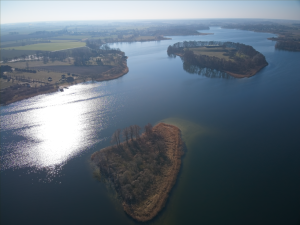The latest issue of the Proceedings of the National Academy of Sciences (PNAS) has released an article on the Piast state's origins. The study combines palaeoecological data with archaeology, history and numismatics, offering a new perspective on the processes accompanying the rise of the first state structures in Polish lands. The publication's authors include researchers from Adam Mickiewicz University, Poznań: Prof. Jakub Niebieszczański, Prof. Katarzyna Marcisz, Prof. Piotr Kołaczek, Prof. Marcin Danielewski and Prof. Mariusz Lamentowicz.
The research was conducted through the joint study efforts of scientists from Polish, German and Swiss centres. The research is the result of long-term cooperation between natural scientists and archaeologists from Poznań, Gdańsk and Dziekanowice, together with historians from Warsaw, Białystok and Berlin and geologists from Cologne and Zurich.
A crucial element of the scientists' work was a highly resolved study of lake sediments from Lednickie Lake - a water body in the centre of the early Piast power complex. Pollen analyses enabled the reconstruction of vegetation changes and land use with an accuracy of about 20 years. As the researchers emphasise, the results point to dramatic environmental transformations in the ninth and tenth centuries, interpreted as an ‘ecological revolution’ providing the basis for political and military structures.
- ‘Thanks to the radiocarbon dating of the sediment core from Lednica Lake, it was possible to obtain a precise time scale, making it comparable with historical and archaeological data,’ says Prof Mariusz Lamentowicz of the AMU Faculty of Geographical and Geological Sciences. - As a result, the core has become a crucial reference point for reconstructing the process of the decline of the original forests around Lednica Lake and the development of settlement in the region. The new data were juxtaposed with the findings of peat bog studies from Greater Poland, Lubusz Land and Pomerania, performed with high-resolution sampling and dating. It provided a unique picture of the changing dynamics of the landscape and wetland ecosystems under the influence of the activities of the Piast state. These processes were recorded in detail in the biogenic sediments. The sediment profile from Lednica Lake is thus a milestone in palaeoecological research in Greater Poland,’ adds Prof. Mariusz Lamentowicz.
As Prof. Katarzyna Marcisz explains, lake or peat sediments - despite not looking spectacular - contain unique information on the history of ecosystems: - We cannot obtain similar data from other sources because, firstly, written data do not extend back into the past as far as the sediments accumulated in various reservoirs, and secondly, often specific ecosystem changes were not documented historically in the archives available to us. Palaeoecological studies give a peek into the past and provide insights into many aspects of ecosystem development - from vegetation and hydrological changes, fires and catastrophic events to human impact. The synthesis of information gained from various sources permits a deep analysis of the data, thus enabling a more precise environmental reconstruction', emphasises Prof Katarzyna Marcisz.
The authors of the publication explain that within one to two generations, the eastern Greater Poland region was widely logged, which created space for intensive cereal agriculture. Grain cultivation, due to its calorific value, storage and transport possibilities, formed the basis for the maintenance of large population centres essential for statehood. This process was accompanied by the development of a settlement network concentrated around the main towns: Gniezno, Poznan, Giecz and Lednica.
The researchers' work indicates that the Piast state's genesis was closely linked to trans-regional trade processes, particularly the slave trade conducted by Scandinavians for Muslim recipients in Central Asia. This exchange, intensifying in the first half of the 10th century, was associated with the silver (dirhams) influx and fostered conditions conducive to the consolidation of local elites.
Simultaneously, the authors indicate that the early Piast state operated under a structural mismatch between a limited ecological base and growing territorial ambitions. Agricultural intensification affected a relatively small area, contributing to the system's fragility. Palaeoecological data indicate that after the mid-11th century, a sharp regression in land use, a decline in cultivation and a re-expansion of secondary forests occurred.
Eventually, though, archaeology confirms the settlement's continuity. The data analysis demonstrates the breakdown of state structures. Greater Poland ceased to function as a political core, and its socio-ecological foundations, crucial to the success of the Piasts, were permanently weakened.
- 'The studies outlined in our paper are an outstanding example of how natural sciences can enrich our knowledge of ancient societies, something that history and archaeology deal with daily,' stresses Jakub Niebieszczański from the AMU Faculty of Archaeology. - As archaeologists, we frequently see an increase or decrease in the quantity of sites over time - in this case, settlements or smaller settlements. However, only when we juxtapose this with results from palaeoecological reconstruction, telling us, for example, about deforestation, crop spikes or phases of forest regeneration, does a complete consideration of the actual dynamics of settlement processes become possible. Our results show the institutionalisation of the use of landscape resources by the rapidly emerging state, but also the scale of its subsequent crisis,’ says Prof. Jakub Niebieszczański.
Prof. Piotr Kołaczek adds: - ‘It is quite remarkable that thanks to pollen, it is now possible to fill in gaps in historical knowledge by reaching back to the formation of the Piast state. This demonstrates that pollen analysis can still ‘tread the waters’ of unexplored scientific problems.
Link to article: https://www.pnas.org/doi/10.1073/pnas.2409056122
Photos:
- An imitation dirham from a hidden dirham treasure in Klukowicze (eastern Poland) buried shortly after 901/902 AD. Imitation dirhams were produced in the primary markets involved in the long-distance trade of exchanging dirhams for thralls; this coin was probably minted in the Khazar Kaganate around 890-900 AD. Photo: Dorota Malarczyk.
- Lake Lednica, including the island, contains the remains of the residence of the first Polish dynasty. Photo: prof. Mariusz Lamentowicz.




